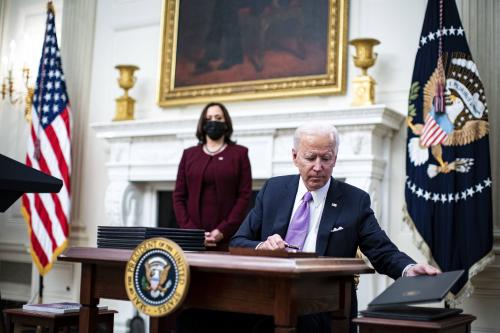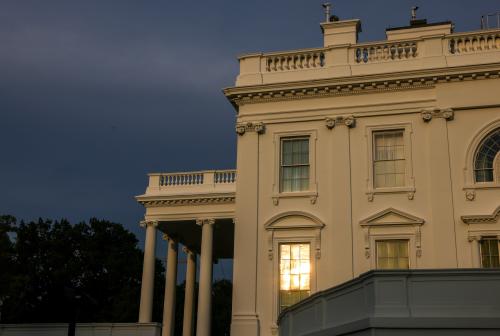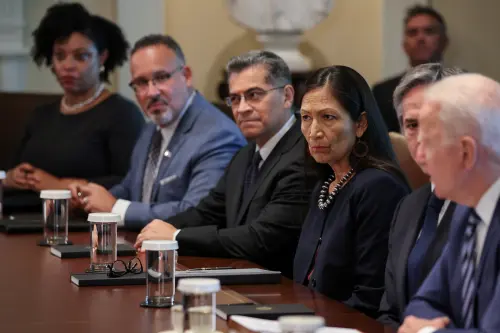The Biden administration’s effort to staff the federal government is proceeding at a snail’s pace compared to previous administrations. Such a leadership vacuum inhibits the administration’s ability to implement their agenda, and while the Senate plays a key role in the process and pace, it is the president who suffers most from this incredibly slow pace.
At day 300, the Biden administration has much to be proud of—passage of the infrastructure bill, the declining unemployment rate, and the record number of federal judges that have been confirmed, among earlier legislative achievements like the American Rescue Plan. According to my Brookings colleague, Russell Wheeler, as of November 17, (Biden’s 300th day in office), the Senate has confirmed 28 federal judges (nine on the court of appeals and 19 on the district courts), surpassing his most recent Democratic predecessor, Barack Obama, who had six judges confirmed by this point and President Trump, who had 13. But while the administration can hail its record-setting appointments to the bench, it is worth noting that confirmed appointees to the executive branch are trickling in at an alarmingly slow pace.
This report marks this project’s third and final opportunity to track the pace of executive branch confirmations and the gender and ethnic diversity of these appointees during President Biden’s first year in office. When I reported on the progress at the 100– and 200-day marks, the Biden confirmation pace lagged behind his three predecessors, while the commitment to nominating large numbers of women and nonwhites represented a historic breakthrough. This study’s data on executive branch confirmations, drawn from Congress.gov, includes comparisons to Biden’s three predecessors and focuses on the fifteen major departments (excluding U.S. Attorneys at the Department of Justice). In addition, there is data on gender and race/ethnicity for each confirmed individual; the categories for the latter are the same as the U.S. Census.
pace of confirmations
After 300 days, the Senate has confirmed 140 of President Biden’s nominees to the 15 major executive departments. The chart below demonstrates that while the Biden administration outpaced President Trump at the start and surpassed the Obama administration in days 200-300, overall President Biden lags behind his predecessors—a troubling, but perhaps not unexpected trendline. Terry Sullivan, a political scientist with the White House Transition Project, shows that the pace of confirmations has been declining for every president since Ronald Reagan, suggesting that even Biden’s successor will have fewer confirmations after 300 days.
Since we began tracking President Biden’s Cabinet and appointees, we have broken them down by department. This enables one to move beyond the aggregate figures and examine confirmations within each of the 15 departments. Such an examination reveals that the Biden administration has the fewest number of confirmed appointees in seven of the 15 departments including Commerce, Defense, Homeland Security, Housing and Urban Development, State, Transportation, and Treasury. Of these, the performance in the State Department is weakest; an unsurprising predicament given the emergence of a Republican blockade by Senators Ted Cruz (R-Tex.), Josh Hawley (R-Mo.), and more recently, Marco Rubio (R-Fla). Working together, they have stalled the confirmations of many senior State Department officials. To provide a clearer sense of just how many appointees are being held up, the Partnership for Public Service indicated that as of November 22, there were 85 pending State Department nominees, 47 of which were awaiting a full vote. This GOP blockade has clearly succeeded as demonstrated by the confirmation records of President Biden compared to his three predecessors on day 300: Biden 27, Trump 55, Obama 92, and Bush 133.
Why does this slow pace matter? Apart from a leadership vacuum that hampers long-term planning and adversely affects morale, the slow pace of confirmation affects government performance. More than 17 years ago, the bipartisan 9-11 Commission released a report that addressed the dangers of delayed confirmations. One of their key recommendations was expeditious confirmation of those appointees working in the national security realm. According to a study by the Partnership for Public Service: The commission found that George W. Bush lacked key deputy Cabinet and subcabinet officials until the spring and summer of 2001, noting that “the new administration—like others before it—did not have its team on the job until at least six months after it took office,” or less than two months before 9/11. We are now 10 months into a new administration and are well behind the confirmation rate of the Bush administration. In short, the situation is far more dire than when the 9-11 Commission issued its report. I suspect the commission would be most disappointed by the Biden administration’s lag in filling top positions at Defense, Homeland Security, and State given the national security implications.
Diversity of confirmations
Aside from the slow pace of confirmations, it is important to point out the historic levels of gender and racial/ethnic diversity among the Biden confirmed appointees. From the start, the administration has demonstrated a high level of commitment to the appointment of women and nonwhites. At the 300-day mark, women represent half of the 140 confirmed appointees, exceeding his three predecessors by a sizeable amount (President Obama was closest with 29% of his appointments going to women).
Similarly, the Biden administration demonstrated a major commitment to appointing nonwhites. After 300 days, 39% of the Biden administration confirmed nominees are nonwhite; representing a stark change from the Trump administration that reached 14% in the first 300 days.
As of November 22, the Partnership for Public Service indicated that there are 175 nominees (to the 15 major departments) languishing somewhere in the Senate confirmation process. This large number suggests that the Biden administration has fulfilled its obligation. Given no choice but to work within the limitations of a slow-moving and sometimes recalcitrant Senate, the Biden administration has made its mark where it can—by appointing the most diverse set of presidential nominees.
Twenty years ago, political scientist Burdett Loomis wrote an article for the Brookings Institution noting “…the lengthening Senate confirmation process indicates that a problem does exist…” If only the Senate operated at the same pace as it did back in 2001, President Biden might have about 326 confirmed nominees instead of well less than half of that number (140). While the slow confirmation pace is not a new phenomenon, it has reached a new low. In prior publications, I tried to account for the slow pace: the 50-50 split in the Senate, the heavy legislative agenda, the frequency and length of Senate recesses, the apparent prioritization of judicial appointments, and the frequency of Republican holds. In the end, the source of the delay is irrelevant. The Senate has a responsibility to vote on the president’s nominees in a timely fashion and I contend that this role is most important at the start of a new administration.
The Biden administration has made history on two fronts and in two starkly different ways—the most diverse set of confirmed appointees and the fewest nominees in place at the 300-day mark. Frustrated by this pace, Majority Leader Schumer (D-N.Y.) recently threatened to keep the chamber in session longer than anticipated so that they could confirm more nominees. If cutting recess or working on weekends motivates Senators to vote on the nominees languishing in the Senate, I am all for it. Leadership matters, particularly at the start of an administration, and giving a president the tools (in this case personnel) he or she needs to govern is good for everyone—Republicans and Democrats alike.
The Brookings Institution is committed to quality, independence, and impact.
We are supported by a diverse array of funders. In line with our values and policies, each Brookings publication represents the sole views of its author(s).








Commentary
Biden’s confirmations progress at the 300-day mark
Snail’s pace continues leaving many high-ranking vacancies across the government
November 24, 2021